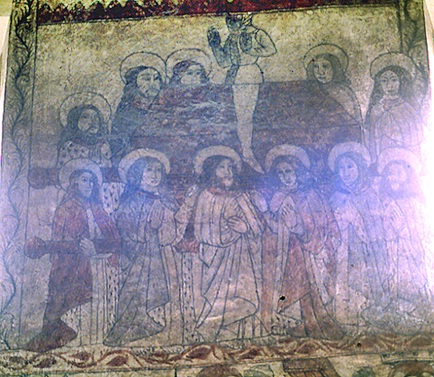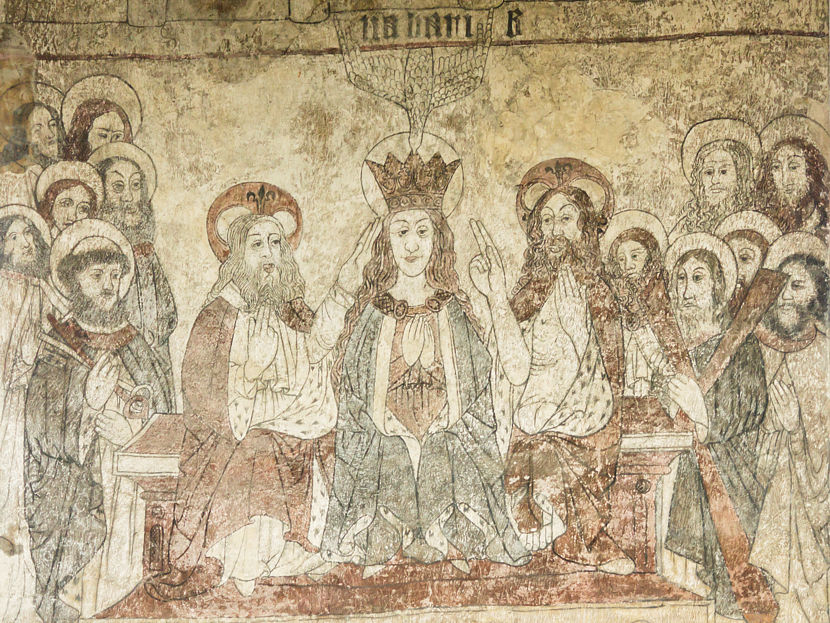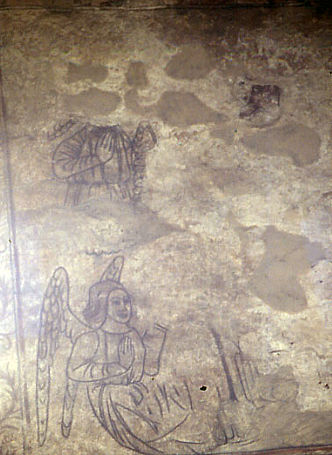Pickering, North Yorkshire (†York) C.15
The Burial, Assumption and Coronation of the Virgin by the Trinity

The painting is very high on the north wall and the photograph is old and murky, but paintings of the burial of the Virgin are rare, and there is only one other on this site – an early 14th century example at Chalgrove in Oxfordshire. A full complement of eleven Apostles (Judas being now gone) carries the bier with the Virgin’s coffin. The major point of interest though is the figure astride the coffin, one of the lookers-on who, according to various early non-biblical sources, objected to the high pomp and ceremony attending Mary’s Burial:
“Someone told them that Mary had departed from the body, and the Apostles were gathered round her, singing hymns. Immediately Satan entered into them and they were filled with anger and said, ‘Come let us go out and kill the Apostles, and let us burn the body that bore that sorcerer’…” ¹
At this point the throng were all struck blind, but one chief priest neverthless found a way to go out of the city and made an attempt to overturn the bier, to which his hands immediately stuck fast.
The Pickering painting seems to show the moment after this, when the repentant High Priest explained his sacrilege and received forgiveness from Peter, a process which freed his hands. Clearly the hands are significant in the painted story, and the High Priest holds them up before him as if to underline this significance, a point which I think may tell us something about the likely source for this particular version of the incident.*

This is where Mary’s earthly story ends. A few English churches, such as Broughton in Oxfordshire, have paintings of her Assumption, and this, in a rather damaged state, is also at Pickering and pictured below. More importantly there is also (photo, left) a very rare example of the Coronation of the Virgin by the Trinity, arguably the highest expression of Marian devotion to be found anywhere at any time. It would certainly have been loathed by iconoclasts of any stripe or period.

Mary sits centrally, crowned, and flanked by God the Father and God the Son, with the Dove of the Holy Spirit hovering directly above her head. An indistinct inscription above her head reads Maria R. It was once longer and possibly read ‘Maria Regina Coeli’. The Apostles, with Peter the tonsured man grasping a very large key on the far left of the photograph, kneel at either side, while above are the battlements of heaven with God, who, in a very rare sighting of this detail in an English church, has the triangular halo appropriate to God the Father, in the centre. At least one angel is beside him and beyond that on either side are, I think, the Fathers of the Church, with the Four Latin Fathers on the right of the photograph. The figure second from the right, wearing the Papal Tiara, is probably Pope (Saint) Gregory the Great.

For a contemporary similarly high conception of the Virgin’s relationship to the Trinity we need to look to Continental Europe, in this case southern France, and the huge 15th century painting by Enguerrand Charonton (or Quarton) in Villeneuve-les-Avignon where the subject is accompanied by an apocalyptic vision of Judgement. Enguerrand’s masterpiece deserves to be better known, but the Pickering Coronation of the Virgin by the Trinity is equally impressive in its unassuming way.
The final painting at Pickering is the damaged and incomplete Assumption of the Virgin, referred to above and painted on the south wall of the church above the Seven Works of Mercy. It is shown at the left for the sake of completeness. Unfortunately there is nothing left of the Virgin herself at all now, and only two angels (probably two of four, with two others once on the right) remain. Mary would have been in the centre of the wall space, possibly painted in a mandorla, or quite possibly in statue form – areas of plaster that seem to be later patches following the removal of a statue suggest this is a possibility.
The other paintings at Pickering are the Martyrdom of St Edmund, the Life of St Catherine, St Christopher, the Seven Works of Mercy referred to above and a very full and detailed Passion Cycle
Website for SS Peter and Paul, Pickering
¹ John of Thessalonica, in Brian E Daley, SJ, ed. On the Dormition of Mary, Early Patristic Homilies, St Vladimir's Press, p. 64
* My own feeling, and it is no more than that, is that the Pickering Coronation may have taken as its model something seen in a play. The York Cycle of Mystery Plays has a fragment (additional to the main cycle) which seems to be a Coronation of the Virgin, and the presence in it of speeches for God the Father and God the Son suggests that it may have been intended as a play of the Coronation of the Virgin by the Trinity. Presumably the fragment never saw the light of day at all – there are hints in what remains that the author was wrestling with the theological complexities of the subject and may well simply have abandoned it. Or remaining parts of it may simply have been lost None of which rules out the possibility of another, different, play on the Coronation of the Virgin being performed locally, perhaps even in Pickering itself. (Purves, The York Cycle of Mystery Plays: The Innholders Fragment, p.383)